Black Interiority: Notes on Architecture, Infrastructure, Environmental Justice, and Abstract Drawing
Artist Torkwase Dyson shares her notes exploring ways to center black subjectivity through artistic abstraction.
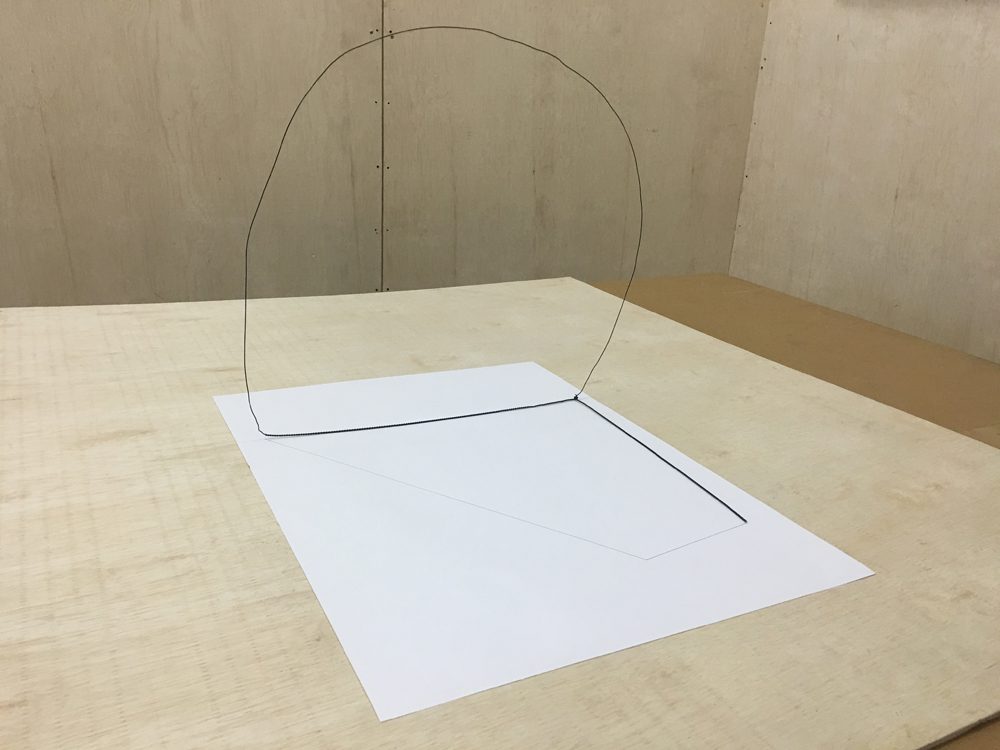
A work from Torkwase Dyson’s Fugitive Architecture (Autonomy and Body) series, 2016-17. Wire and ink on paper. Courtesy the artist.
1. Drawing_001_1865
In built and natural environments, each object helps define our conditions of movement. The design of our physical world informs the methods in which motion emerges and spatial strategy is organized. For black people, moving through a given environment comes with questions of belonging and a self-determination of visibility and semi-autonomy. This means for the systemically disenfranchised, compositional movement (ways in which the body unifies, balances, and arranges itself to move through space) is a skill used in the service of self-emancipation within hostile geographies. Further, the brain deciphers, measures, categorizes, and understands both immediate and distant physical forms in relationship to the spatial structures defined by the conditions of power.
This relationship of interior and exterior—black mind/body geographic experiences—is inextricably tied to lands and waters riddled with architectural and infrastructural histories designed to isolate control over clean natural resources within white conservative and corporate hyper-capitalist systems. Disenfranchised people of color have inherited this geographic isolation and can name it environmental racism. In this moment of accelerated globalization due to technology, environmental racism is exacerbated by human-induced climate change, or what is being declared the Anthropocene. The legacy of environmental racism and the current traumas of global climate change make spatial planning—architectural and infrastructural representation and design—an urgent concern for me in contemporary abstract drawing.
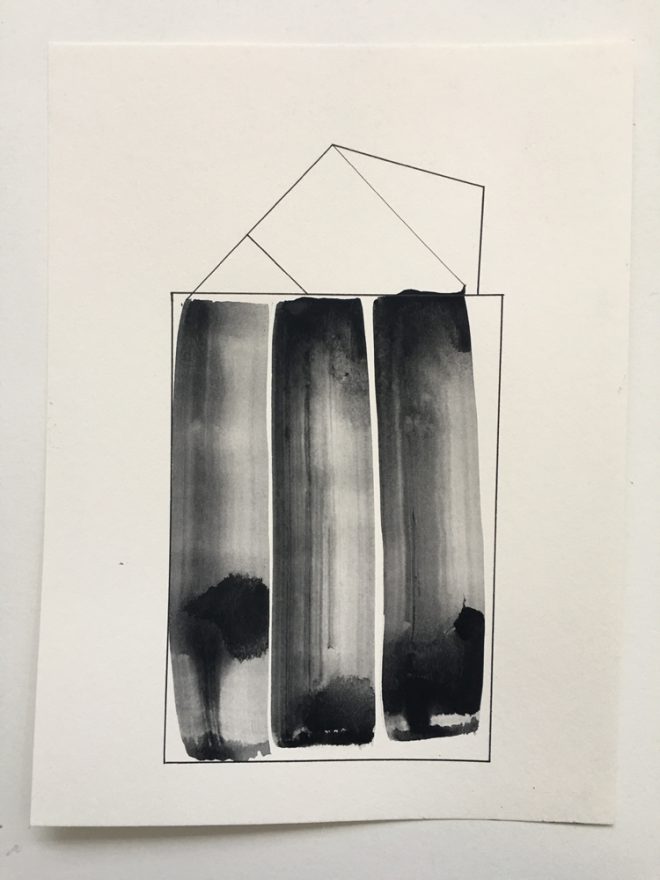
A work from Torkwase Dyson’s Fugitive Architecture (Autonomy and Body) series, 2016-17. Gouache on paper. Courtesy the artist.
2. Notes: On Planning Black Spatial Strategies as Users (In Process)
A. Aim_
My efforts are focused on developing a distilled abstract drawing practice in the language of architectural and infrastructural representation that lends itself to participation in spatial development and more livable geographies. In drawing, I develop compositions, diagrams, marks, surfaces, and models toward these ends, always with the movement of the human body in mind. Each drawing is a form of analysis, looking at the efficiencies in our current built and natural environments and the relationships people of color have to them.
B. Micro Subjects_
Levees, bridges, water tables, buildings, railroads, septic tanks, dams, houses, warehouses, cables, pipes, meadows, bunkers, trains, ships, mountains, rivers, sidewalks, corners, crosswalks, stairs, walls. As we navigate built environments we did not design, that we’ve learned through our experiences, authority over one’s mind/body in the labyrinth of forms, spaces, and objects is a question of race, composition, and materiality. From the concrete form of failed levees in New Orleans to the three 60-by-60-inch concrete sidewalk squares underneath Eric Garner, we must be able to interrogate current infrastructure with new design solutions to advanced environmental conditions with our political and material futures in mind.
C. Macro Subjects_
Architectural zones, global standardization, fiber optics, water systems, telecommunications, aviation, NATO, the World Bank, railroads, corporations, private enterprise, industry. As we navigate these infrastructural operating systems that inform our built environments but are often not fixed architectural forms, we learn through a different kind of user experience that sovereignty over land, earth, and ground is a question of dignity.
Architectural and infrastructural representation has given me an expressive voice in conversations on spatial movement, development, organization, and design. It is a visual language that is capable of describing or illustrating macro ideas of systemic order or the profound spatial strategies of fugitivity. Within the context of abstract drawing, planning futures and investigating ongoing historical methods of spatial survival are direct lines of action/participation to environmental justice. The ability to create representational drawings that describe more livable spaces and how we feel about them or describe existing space that we must come to know and understand their operational capacity and how we feel about them is critical to creating the conditions under which environmental transformation occurs. Change is happening now and I understand contemporary abstract drawing as a major part of our current preparedness movement.
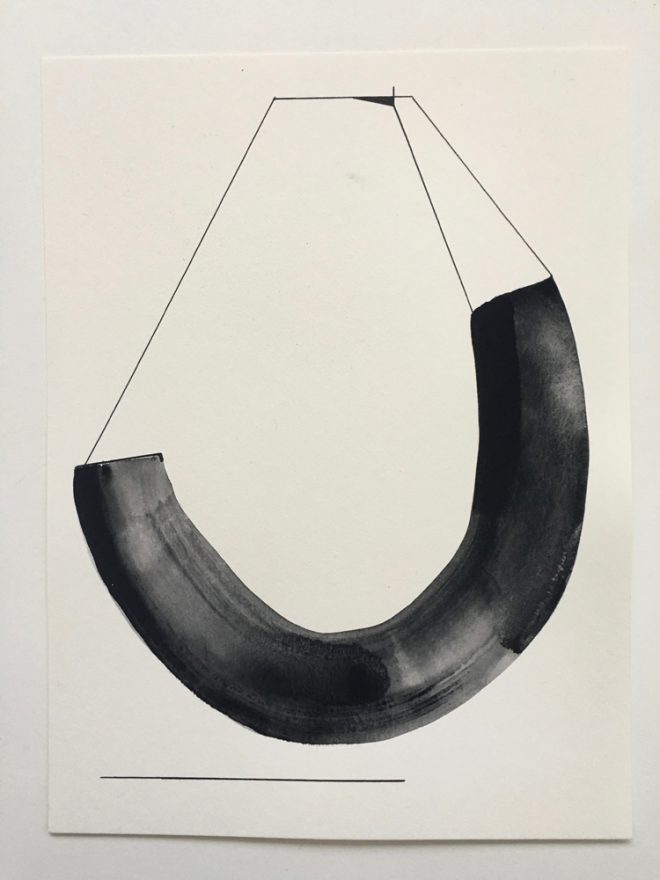
A work from Torkwase Dyson’s Fugitive Architecture (Autonomy and Body) series, 2016-17. Gouache on paper. Courtesy the artist.
3. Black Compositional Thought: Between Representation and Abstraction Drawing
In my practice the perfect challenge of making distilled abstract drawing is developing a mindful awareness of lines and shapes that recognize the abilities of black bodies to expressively inhabit and negotiate constructions of space and materiality in real time. Another challenge is to produce compositions where the geometry of the image and object recognizes intuitive capabilities of the mind to articulate the abilities of space as a form. I’ve set up this mode of drawing as a way to respond to the conditions in which various systemic orders of political abstraction have been used in the service of environmental exploitation.
A. I ask myself, how do black people survive abstraction today as the scope, scale, and density of matter is changing all around us due to climate change? I begin to answer by looking at what I call black compositional thought. Abstract drawing can lend itself to the intellectual and psychological pursuit of pulling black compositional thought close. Really close, inside close. From the black-inside-black position, I stand in front of a surface with my mind in complete awareness of form as power. As I begin to convey shape, line, movement, weight, scale, proximity, and perspective, representations of subjects oscillate between scaled diagrammatic images and expressive drawings. In the act of making I understand that it is the integrations of forms folded into the conditions of black spatial justice where I begin to develop compositions and designs that respond to materials. Here I open up the power of abstract representation while engaging with the emotional implications of design space itself. This is the critical tension in the development of solutions that extend beyond the surface area of the drawing and empathy and into measurable, efficacious applications. What emerges are ideas and capabilities in relationship to how we invent in response to the varied material, geographic, and political conditions we inherit. I begin to work from a state of deep subjectivity in the drawings while aligning my thoughts with black spatial strategies designed and constructed to improve livability. These references range from the nomadic vernacular of the Taureg people and the spatial planning of Cameroonian architecture to the stories of Anthony Burns and Assata Shakur, just to name a few. Taking these histories into account, I begin to understand that surviving abstraction through abstraction is my environmental project today.
B. The abstraction I refer to is also the political abstraction used to enact hyper-capitalist and white conservative racist agendas upon black and brown geographies. For example, the history of policing and vagrancy laws, extraterritorial jurisdiction, and the exclusion of subjectivity in the discussion of the Anthropocene are all systems of political abstraction enacting modes of economic conservatism. These systems continue to traumatize as we are forced out and away from lands and waters that give us life and form our identities. This legacy of forced movement includes the intercontinental slave trade, environmental terrorism in the form of lynch mobs and the KKK, the burning of black towns and churches, coal mining, failing infrastructures due to disinvestment and underinvestment, the industrial and nuclear revolution, toxic waste contamination from industrial run-offs, rising sea levels, redistricting, curfew laws, the decrease in biodiversity, droughts, and the colonization of water for extraction industries. Political abstraction set the geographic conditions for global spatial and environmental inequalities. In addition, the ways in which we see, write, and talk about these inequalities must be in relationship to our current climate crisis. There must be a broader narrative of black subjectivity in relationship to the Anthropocene. The Anthropocene project does not exist without the land, body, and labor of people of color in the modern design experiment. The absence of black labor politics in relationship to natural resources and early forms of architecture, agriculture, and engineering is an abstraction and continues to induce already harsh vulnerability through further erasure. Abstract drawing enables a pointed discussion of these structural histories and our participation in them. It can also prepare our minds to compose with space and materiality that will define our future.
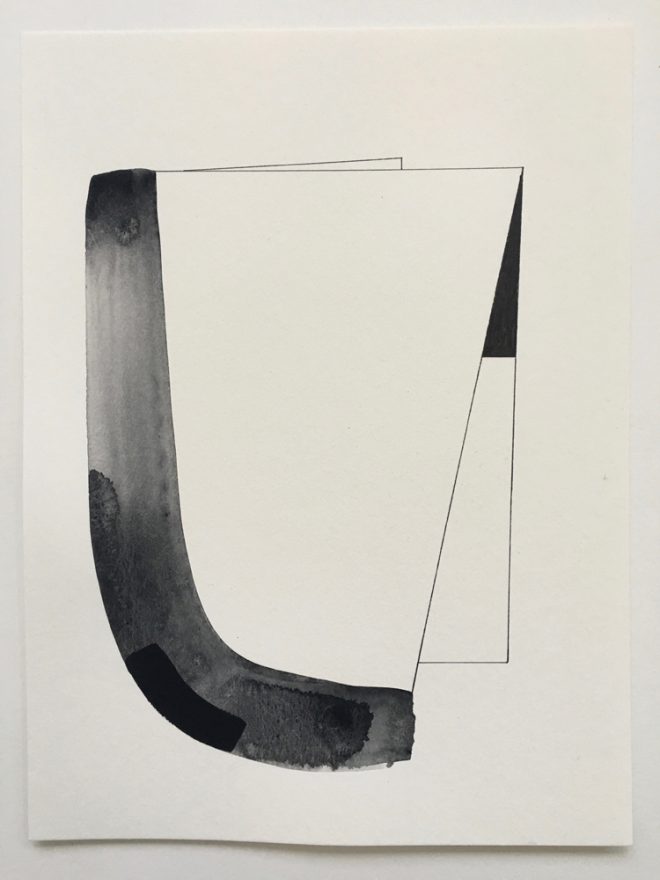
A work from Torkwase Dyson’s Fugitive Architecture (Autonomy and Body) series, 2016-17. Gouache on paper. Courtesy the artist.
4. Flows of Environmental Information (Ongoing)
Infrastructure, architectural space, and the abuse of natural resources continue to make habitation, mindfulness, and movement urgent political matters for black bodies. These ideas continue to be informed by my work with Danielle Purifoy and her research on black landownership; land preservation and loss; local economic development; the imposition of environmental burdens; and the provision of environmental services—particularly access to clean water and wastewater sanitation.
As I write this, President Obama is shaking Donald Trump’s hand because Trump is president-elect of the United States of America. It is common knowledge that Trump is a climate-change denier. (In a recent interview with The New York Times, he skirted the issue though, saying he has an “open mind” and that there is “some connectivity” between human activity and climate change.) Trump is a major supporter of the oil and gas industries and is in the position to repeal the Paris Agreement, an international pact supported by the Obama administration to address climate change. Although the Paris Agreement does not go far enough to combat global warming, Trump could make things much worse by pushing for a vast decrease in carbon regulations and an increase in the expansion of extractive industries. Donald Trump has placed his cruel and dangerous ideology over science. We are faced now more than ever with rising temperatures; a decrease in the growing season; droughts and heat waves; rising sea levels; and intensifying hurricanes. Climate change exacerbates every other inequality. We must design and plan for a low-carbon economy because environmentalism, geography, and race are directly connected.
As I’m writing these notes, COP22 is happening in Marrakech—a conference where countries all over the world are working for environmental justice and economic growth through renewable energies. Right now, Africa continues to suffer severely from the impacts of climate change. Given the hoarding of its natural resources and areas of concentrated extraction, the continent is particularly vulnerable to rising CO2 levels and their damaging effects, such as droughts, flooding, unreliable crop yield, and waning ecosystems. This while being economically devastated by oil and gas industries who refuse to recognize the intersections of production, profit, the body, and space. Corporate industries assume very little, if any, accountability for the lived experiences of the people living in these extraction zones. This is a conundrum that takes many forms across the continent. From my own research and experience, I know it is the engineers and architects of the Global South that lead the fight for new technologies to deal with the environmental soot global consumption produces.
Stateside, environmental activists and supporters of the Sioux tribe are trying to stop the Dakota Access Pipeline, a 1172-mile, 30-inch-diameter oil pipeline project financed by Energy Transfer Partners, in which Trump has a range of financial investments. Kelcy Warren, CEO of Energy Transfer Partners, says, “I’m 100 percent sure that the pipeline will be approved by a Trump administration.” An oil spill from this pipeline would permanently contaminate the Missouri River, a major water source for millions living in cities downstream. I support the Standing Rock Sioux Tribe and the environmental activists trying to stop the pipeline and fight for First People’s right to sovereignty.
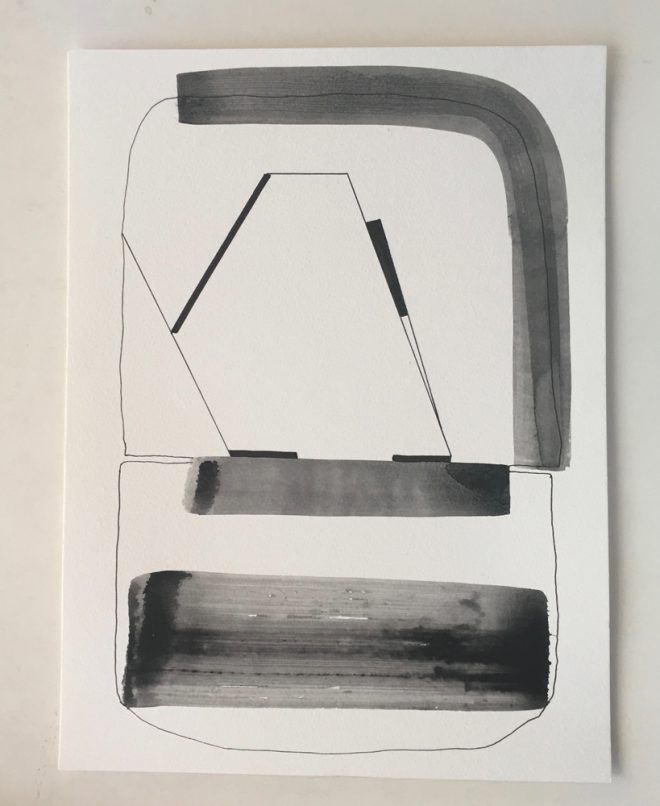
A work from Torkwase Dyson’s Fugitive Architecture (Autonomy and Body) series, 2016-17. Gouache on paper. Courtesy the artist.
5. A Response: SSZ and the Wynter-Wells Drawing School for Environmental Justice
Studio South Zero is a tiny mobile solar powered art studio I built to cross the country, exploring geographic sites influenced by climate change and environmental injustice. It was the integration of abstract drawing, design, and technology that led me to make this portable studio. By nature, this nomadic practice generates both environmental interdependency and solitude. Using this space allows the embrace of all that comes with it: the mundane, the complex, the fears, and the beauty. SSZ is a living, fluid space—a lifestyle which makes it possible for me to make my art and support other people’s projects, too. It was working in SSZ that inspired my new project, the Wynter-Wells Drawing School for Environmental Justice, building on the work of Sylvia Wynter and Ida B. Wells. This is a conceptual project combining the curricular concerns of art with design theories of geography, infrastructure, engineering, and architecture. My aim is to research and assemble an experimental curriculum and a formal language focused on the progressive ideas of diagrammatic and expressive spatial representation. I am using two strategies of spatial representation: elevation drawings, the projections of an object when it is viewed from the front, and section drawings, the projection of a cut section of an object. Both approaches lend themselves simultaneously to the analysis of science, fragmentation, site, and the culture of spatial engineering, architecture, and geography. I’ll be working with these drawing ideas side by side to produce a new systemic representations that consider techniques for participation in spatial planning toward environmental justice.



